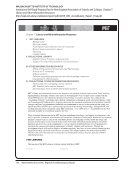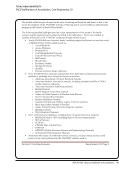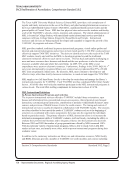116 · Representative Documents: Regional Accrediting Agency Reports
Brigham Young University
Northwest Commission on Colleges and Universities (NWCCU). Library and Information Resources 5
summer terms, senior library leaders establish annual and multiyear goals for the library and its
divisions.
Evaluation of Services and Collections
Establishing a culture of assessment in the Lee Library was one of the key objectives to
emerge from the Lee Library’s 2000 strategic planning process. Consequently, the Lee Library
repurposed an existing position to hire an assessment officer. This process improvement
specialist coordinates the collection and dissemination of library measures and leads specific
assessment projects.
Traditionally, research libraries measured their quality in terms of collection size and
expenditures, but recently the trend has shifted toward outcomebased assessments that gauge
performance and improvement. The Lee Library’s process improvement specialist is responsible
for designing and conducting studies aimed at measuring the effectiveness of library services.
Under his direction, the library conducts faculty and staff focus groups, formal and informal
surveys, and one-on-one observations. In addition, students and faculty can express opinions and
provide feedback at any time through the library Web site.
Both the Lee and Hunter Libraries have participated in LibQUAL+, the library service
quality assessment tool sponsored by ARL in conjunction with Texas A&M University. The Lee
Library participated in 2001 and 2003, then in 2004 and 2006 joined member libraries of the
Consortium of Church Libraries and Archives (CCLA) in a consortia-wide LibQUAL+
assessment. Results led to changes in both strategic and operational directions in the libraries.
For example, LibQUAL+ comments about lack of resources resulted in an annual budget
allotment for new databases and journals. Feedback led to additional studies of reference service
and the role of subject librarians, which in turn resulted in more direct interaction with students
and faculty. LibQUAL+ concerns over noisy study areas resulted in establishment of both
“Noise-Free” and “No Shhh” zones. (For more LibQUAL+ results, see RE 5.5.)
The libraries regularly seek formal input from students in library instruction sessions, and
in early 2005 the Lee Library participated in the ARL project for the standardized assessment of
information literacy skills (SAILS). Reference activity was also assessed in 2005 through
WOREP, the Wisconsin Ohio Reference Evaluation Program. The Lee Library conducts
usability tests as revisions and updates are made to the library Web page. Other formal feedback
mechanisms are regularly developed to measure satisfaction with specific library programs.
An extensive resource usage study of the Lee Library was conducted in 2001–2002 at the
request of the associate academic vice president for research and graduate studies (Harold B. Lee
Library Resource Usage Study). Results of the study indicated that the Lee Library “continues to
remain the ‘heart of campus’” and contributes to the academic and social well-being of students,
faculty, and staff (RE 5.14).
This study served as the foundation for establishing a Web-based statistical information
system where critical library data are made available online and on demand. A wide variety of
current and historical data related to utilization of collections, services, and facilities are reported
through this system (RE 5.14).
The libraries continue to support statistical surveys administered by library consortia and
national agencies. Changes in collecting and reporting methods have improved data accuracy and
altered library rankings generated from the surveys. Detailed collection and use statistics are in
RE 5.3 and RE 5.4.
Brigham Young University
Northwest Commission on Colleges and Universities (NWCCU). Library and Information Resources 5
summer terms, senior library leaders establish annual and multiyear goals for the library and its
divisions.
Evaluation of Services and Collections
Establishing a culture of assessment in the Lee Library was one of the key objectives to
emerge from the Lee Library’s 2000 strategic planning process. Consequently, the Lee Library
repurposed an existing position to hire an assessment officer. This process improvement
specialist coordinates the collection and dissemination of library measures and leads specific
assessment projects.
Traditionally, research libraries measured their quality in terms of collection size and
expenditures, but recently the trend has shifted toward outcomebased assessments that gauge
performance and improvement. The Lee Library’s process improvement specialist is responsible
for designing and conducting studies aimed at measuring the effectiveness of library services.
Under his direction, the library conducts faculty and staff focus groups, formal and informal
surveys, and one-on-one observations. In addition, students and faculty can express opinions and
provide feedback at any time through the library Web site.
Both the Lee and Hunter Libraries have participated in LibQUAL+, the library service
quality assessment tool sponsored by ARL in conjunction with Texas A&M University. The Lee
Library participated in 2001 and 2003, then in 2004 and 2006 joined member libraries of the
Consortium of Church Libraries and Archives (CCLA) in a consortia-wide LibQUAL+
assessment. Results led to changes in both strategic and operational directions in the libraries.
For example, LibQUAL+ comments about lack of resources resulted in an annual budget
allotment for new databases and journals. Feedback led to additional studies of reference service
and the role of subject librarians, which in turn resulted in more direct interaction with students
and faculty. LibQUAL+ concerns over noisy study areas resulted in establishment of both
“Noise-Free” and “No Shhh” zones. (For more LibQUAL+ results, see RE 5.5.)
The libraries regularly seek formal input from students in library instruction sessions, and
in early 2005 the Lee Library participated in the ARL project for the standardized assessment of
information literacy skills (SAILS). Reference activity was also assessed in 2005 through
WOREP, the Wisconsin Ohio Reference Evaluation Program. The Lee Library conducts
usability tests as revisions and updates are made to the library Web page. Other formal feedback
mechanisms are regularly developed to measure satisfaction with specific library programs.
An extensive resource usage study of the Lee Library was conducted in 2001–2002 at the
request of the associate academic vice president for research and graduate studies (Harold B. Lee
Library Resource Usage Study). Results of the study indicated that the Lee Library “continues to
remain the ‘heart of campus’” and contributes to the academic and social well-being of students,
faculty, and staff (RE 5.14).
This study served as the foundation for establishing a Web-based statistical information
system where critical library data are made available online and on demand. A wide variety of
current and historical data related to utilization of collections, services, and facilities are reported
through this system (RE 5.14).
The libraries continue to support statistical surveys administered by library consortia and
national agencies. Changes in collecting and reporting methods have improved data accuracy and
altered library rankings generated from the surveys. Detailed collection and use statistics are in
RE 5.3 and RE 5.4.
























































































































































































